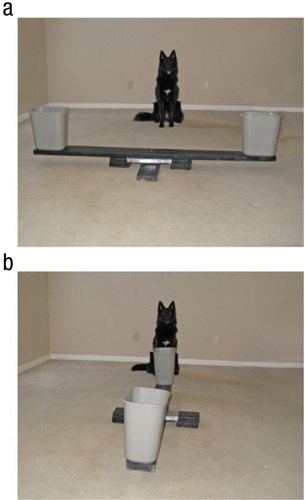Sport and Competition
Dogs and Object Permanence
Do dogs remember where hidden objects are located?
Posted February 5, 2018 Reviewed by Jessica Schrader

The work of Jean Piaget shaped our understanding of cognitive development in children, and it also gave us several tasks that we can use to study other animals. One classic issue studied by Piaget is object permanence. That is, do children realize that an object that disappears behind some obstruction still exists?
This question is not trivial. When an object is put behind some other object, it can’t be seen anymore. Although adults clearly know that objects continue to exist, perhaps children operate with the assumption “out of sight, out of mind.” Decades of work on this topic suggest that young children’s performance with hidden objects is mixed. Very young children will not reach for objects they cannot see, but they do express surprise when watching scenes in which objects behind a screen disappear.
What about dogs?
Anyone who has owned a dog knows that it will continue to chase after a ball that rolls under a sofa, but it is possible that the dog still smells the object, and so that it why they continue to pursue it. As luck would have it, several excellent studies of dogs’ ability to reason about hidden objects have been done, and they have been summarized in a paper in the October, 2016 issue of Current Directions in Psychological Science by Thomas Zentall and Kristina Pattison.
One key way of assessing whether a dog can remember an object is not visible is to use an invisible displacement task. In this task, an object is hidden, and then moved in some way. The question is where the dog will search to find the object.

For example, in one version of the task, two buckets were placed on either side of the plank. A treat was hidden in the bottom of the bucket (in a container so that the dog would not be able to smell the treat). Then, while the dog was watching, the plank was rotated 180 degrees so that the treat is now on the opposite side of the dog. In this case, the dog generally searches in the location where the treat was hidden initially rather than in the bucket that currently has the treat.
So, from this you might think dogs don’t have a sense of where hidden objects are located. But, this version of the task is quite difficult, because the current location of the treat competes with the location where the dog saw the treat hidden. In another version of the task, the plank starts so that one bucket is near the dog and one is far away. Then, the plank is rotated only 90 degrees, so that there is no competition between the locations. In this case, the dog almost always searches in the bucket with the treat. In addition, in two other conditions, the buckets stay in the same location, but the dog is walked either 90 degrees around the apparatus or 180 degrees around it. In this case, the dog always searches in the right place. So, dogs do seem to have a pretty good idea of where hidden objects are.
However, one way that dogs do this task is through gaze. They will actually watch the location of the hidden object. If the lights are turned out after the plank is moved or if there is a long delay is between the rotation of the plank and when the dog can search, the dogs don’t do as well, though a few dogs are still able to do this task, even with delays as long as four minutes.
Finally, in some clever studies, dogs see dog biscuits hidden behind a screen. Later, a biscuit is taken from behind the screen. The biscuit is either identical to the one the dog saw hidden or it differs in size or color. (Dogs don’t have quite the same color vision as humans, but they are able to distinguish blue objects from yellow ones. They don’t have cones sensitive to red and green as humans do.)
In this study, the experimenters measured how long the dogs looked at the object taken from behind the screen. If they were ‘surprised’ at what emerged, they should look longer than if they expected to see what came from behind the screen. Dogs looked longer both for changes in size and changes in color compared to when an identical treat was taken from behind the screen, suggesting that they remembered what had been hidden behind the screen.
Overall, dogs have some ability to remember the qualities of objects that are not visible. The authors of the article suggest that the ability of dogs to deal with hidden objects is about the same as are observed with 1- to 2-year-old humans.
References
Zentall, T.R., & Pattison, K.F. (2016). Now you see it, now you don't: Object permanence in dogs. Current directions in psychological science, 25(5), 357-362.


